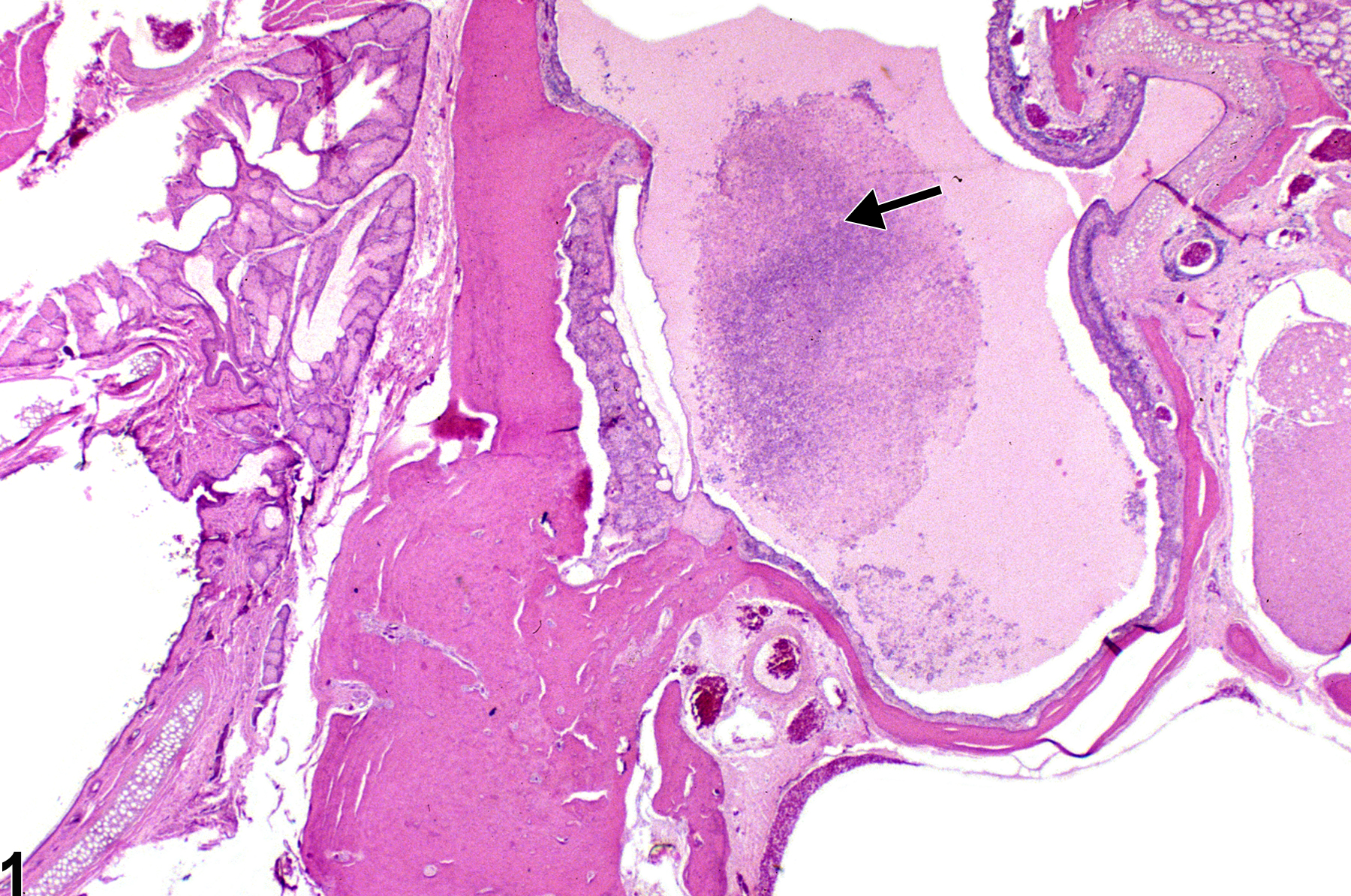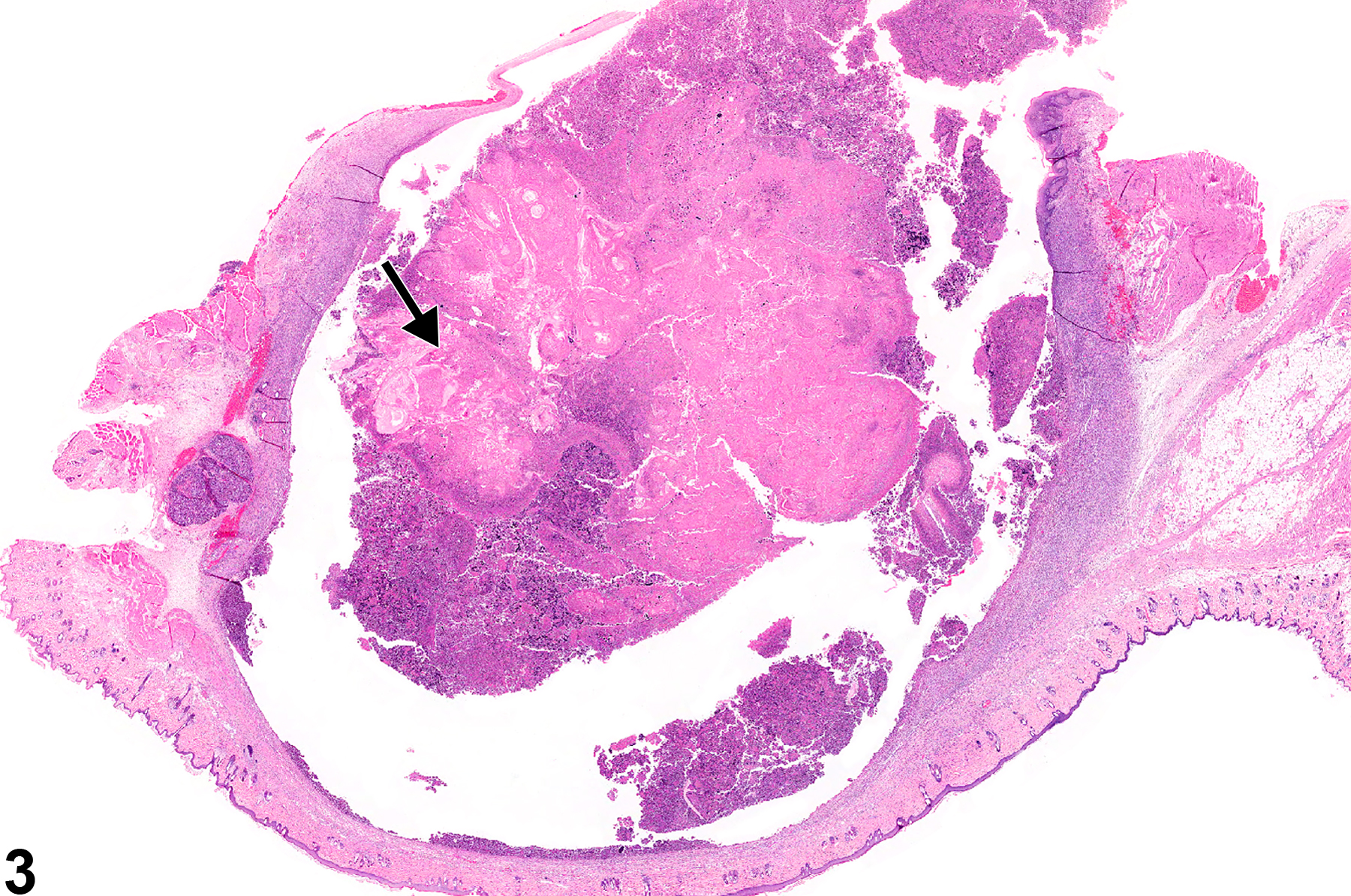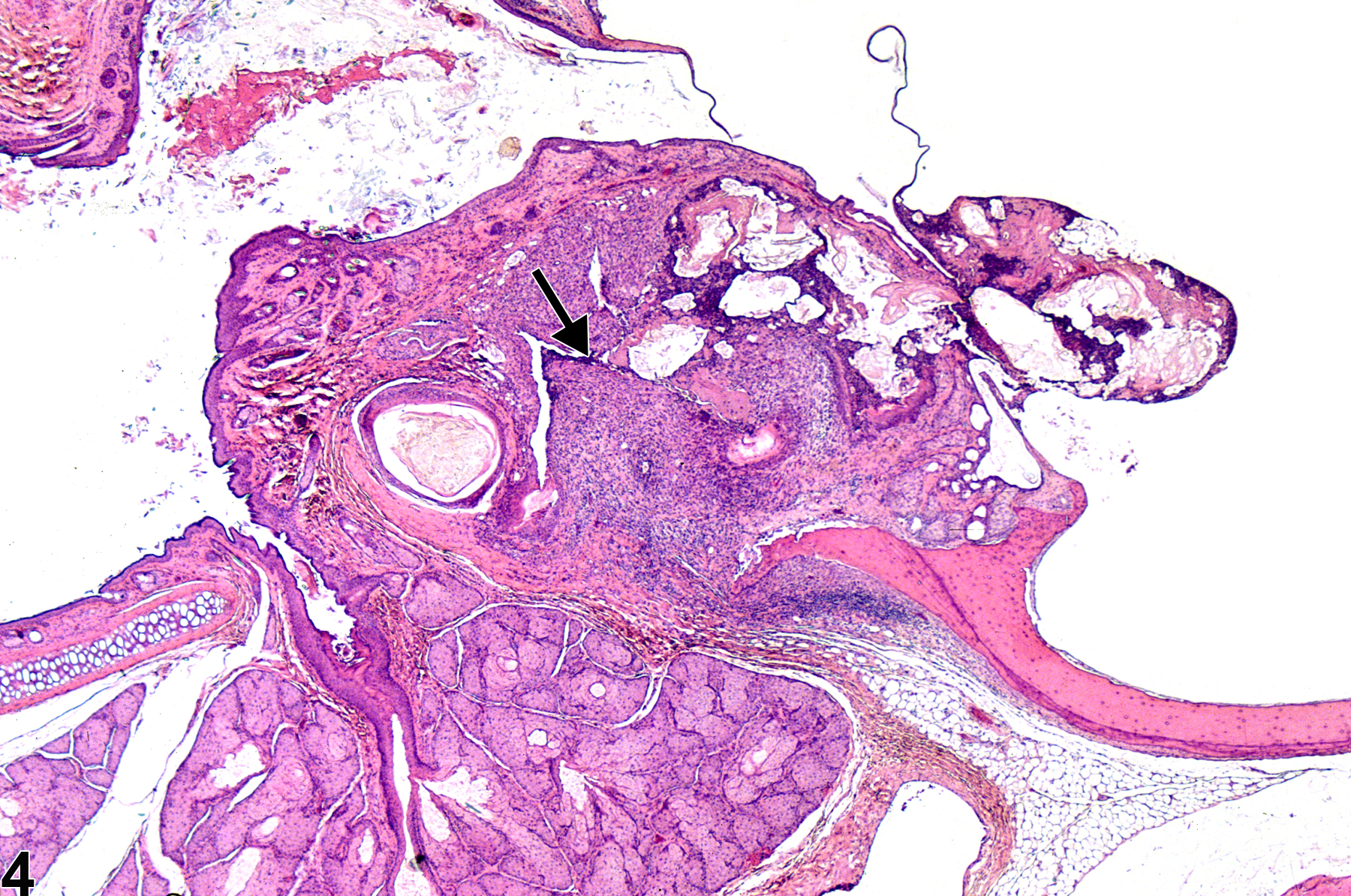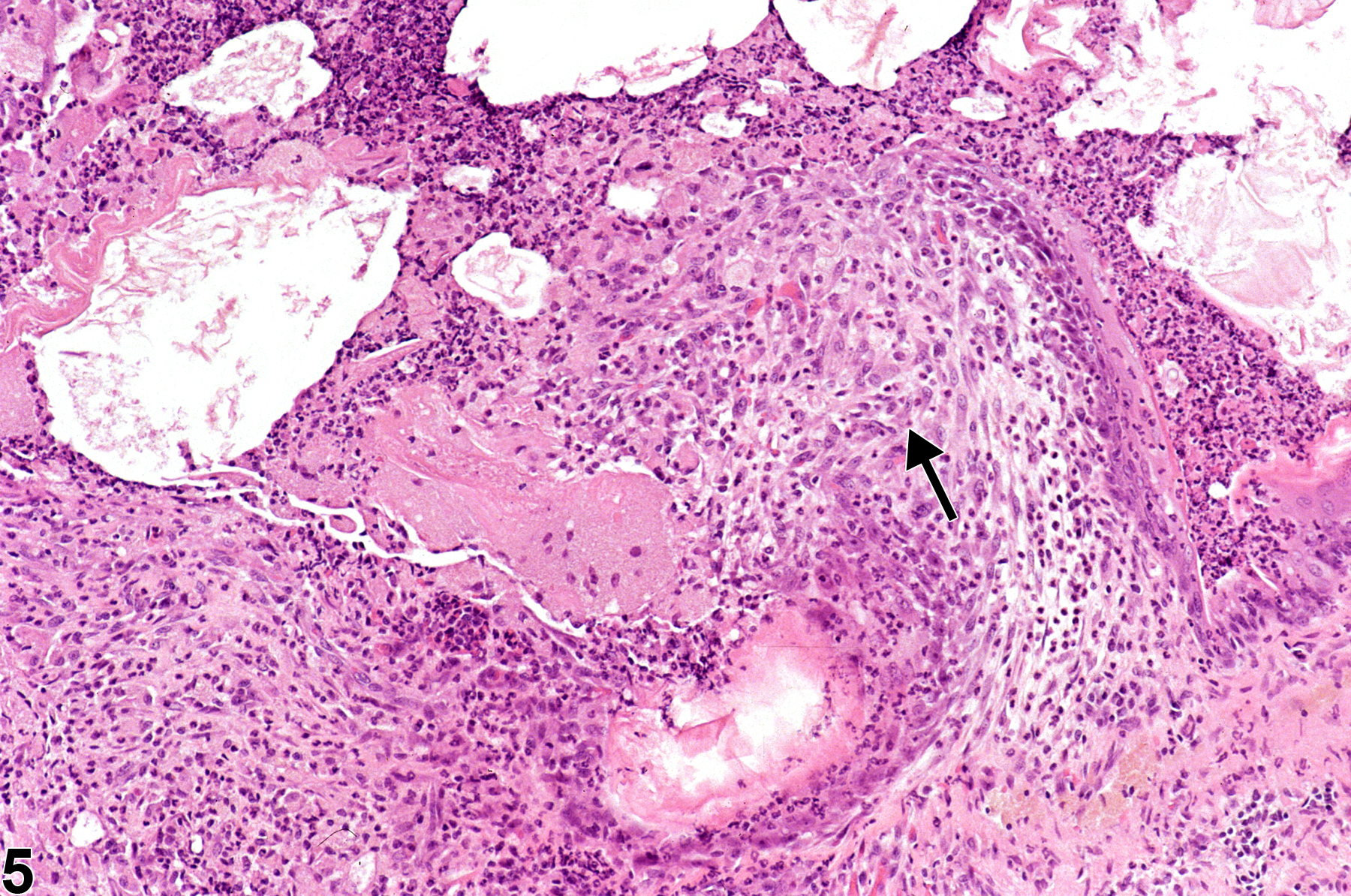Special Senses System
Ear - Inflammation
Narrative
In NTP studies, there are five standard categories of inflammation: acute, suppurative, chronic, chronic-active, and granulomatous. In acute inflammation, the predominant infiltrating cell is the neutrophil, though fewer macrophages and lymphocytes may also be present. There may also be evidence of edema or hyperemia. The neutrophil is also the predominant infiltrating cell type in suppurative inflammation, however, in suppurative inflammation, the neutrophils are aggregated and many of them are degenerate (suppurative exudate). Cell debris, both from the resident cell populations and infiltrating leukocytes, proteinaceous fluid containing fibrin, fewer macrophages, occasional lymphocytes or plasma cells, and, possibly, an infectious agent may also be present in within the exudate. Grossly, these lesions would be characterized by the presence of pus. In the tissue surrounding the exudate, there may be fibroblasts, fibrous connective tissue, and mixed inflammatory cells, depending on the chronicity of the lesion. Lymphocytes predominate in chronic inflammation. Lymphocytes also predominate in chronic-active inflammation, but in chronic-active inflammation, there are also a significant number of neutrophils. Both lesions may contain macrophages. Granulomatous inflammation is another form of chronic inflammation, but this diagnosis requires the presence of a significant number of aggregated, large, activated macrophages, epithelioid macrophages, or multinucleated giant cells.
Dogru S, Haholu A, Gungor A, Kucukodaci Z, Cincik H, Ozdemir T, Sen H. 2009. Histologic analysis of the effects of three different support materials within rat middle ear. Otolaryngol Head Neck Surg 140:177-182.
Abstract: https://www.ncbi.nlm.nih.gov/pubmed/19201284Huang C-C, Shi G-S, Yi Z-X. 1988. Experimental induction of middle ear cholesteatoma in rats. Am J Otolaryngol 9:165-172.
Abstract: https://www.ncbi.nlm.nih.gov/pubmed/3265859MacArthur CJ, DeGagne JM, Kempton JB, Trune DR. 2009. Steroid control of acute middle ear inflammation in a mouse model. Arch Otolaryngol Head Neck Surg 135:453-457.
Full Text: http://archotol.jamanetwork.com/article.aspx?articleid=410115MacArthur CJ, Trune DR. 2006. Mouse models of otitis media. Curr Opin Otolaryngol Head Neck Surg 14:341-346.
Abstract: https://www.ncbi.nlm.nih.gov/pubmed/16974149Maeda K, Hirano T, Ichimiya I, Kurono Y, Suzuki M, Mogi G. 2004. Cytokine expression in experimental chronic otitis media with effusion in mice. Laryngoscope 114:1967-1972.
Full Text: http://onlinelibrary.wiley.com/doi/10.1097/01.mlg.0000147930.29261.51/fullNational Toxicology Program. 1982. NTP TR-193. Bioassay of Reserpine for Possible Carcinogenicity (CAS No. 50-55-5). NTP, Research Triangle Park, NC.
Abstract: https://ntp.niehs.nih.gov/go/10117National Toxicology Program. 1986. NTP TR-259. Carcinogenesis Studies of Ethyl Acrylate (CAS No. 140-88-5) in F344/N Rats and B6C3F1 Mice (Gavage Studies). NTP, Research Triangle Park, NC.
Abstract: https://ntp.niehs.nih.gov/go/13957National Toxicology Program. 1993. NTP TR-394. Toxicology and Carcinogenesis Studies of Acetaminophen (CAS No. 103-90-2) in F344 Rats and B6C3F1 Mice (Feed Studies). NTP, Research Triangle Park, NC.
Abstract: https://ntp.niehs.nih.gov/go/12239National Toxicology Program. 1993. NTP TR-420. Toxicology and Carcinogenesis Studies of Triamterene (CAS No. 396-01-0) in F344/N Rats and B6C3F1 Mice (Feed Studies). NTP, Research Triangle Park, NC.
Abstract: https://ntp.niehs.nih.gov/go/8057Piltcher OB, Swarts JD, Magnuson K, Alper CM, Doyle WJ, Hebda PA. 2002. A rat model of otitis media with effusion caused by Eustachian tube obstruction with and without Streptococcus pneumoniae infection: Methods and disease course. Otolaryngol Head Neck Surg 126:490-498.
Abstract: https://www.ncbi.nlm.nih.gov/pubmed/12075222Widemar L, Hellström, Stenfors L. 1986. Different structural changes in membrane Shrapnelli in serous and purulent otitis media: An experimental study in the rat. Acta Otolaryngol 102:266-273.
Abstract: https://www.ncbi.nlm.nih.gov/pubmed/3776521Wright CG, Pawlowski KS, Roland PS, Meyerhoff WL. 2000. An animal model for external ear canal inflammation. Laryngoscope 110:1112-1118.
Abstract: https://www.ncbi.nlm.nih.gov/pubmed/10892679Yoshitomi K, Brown. 1990. HR. Ear and pinna. In: Pathology of the Fischer Rat: Reference and Atlas (Boorman GA, Eustis SL, Elwell MR, Montgomery CA, MacKenzie WF, eds). Academic Press, San Diego, CA, 227-238.
Abstract: https://www.ncbi.nlm.nih.gov/nlmcatalog/9002563
Ear - Inflammation, Acute in a male Fischer 344/N rat from a chronic study. There is predominantly neutrophilic infiltrates in the epithelium and lamina propria and abundant neutrophils and proteinaceous fluid in the external ear canal (arrow).






